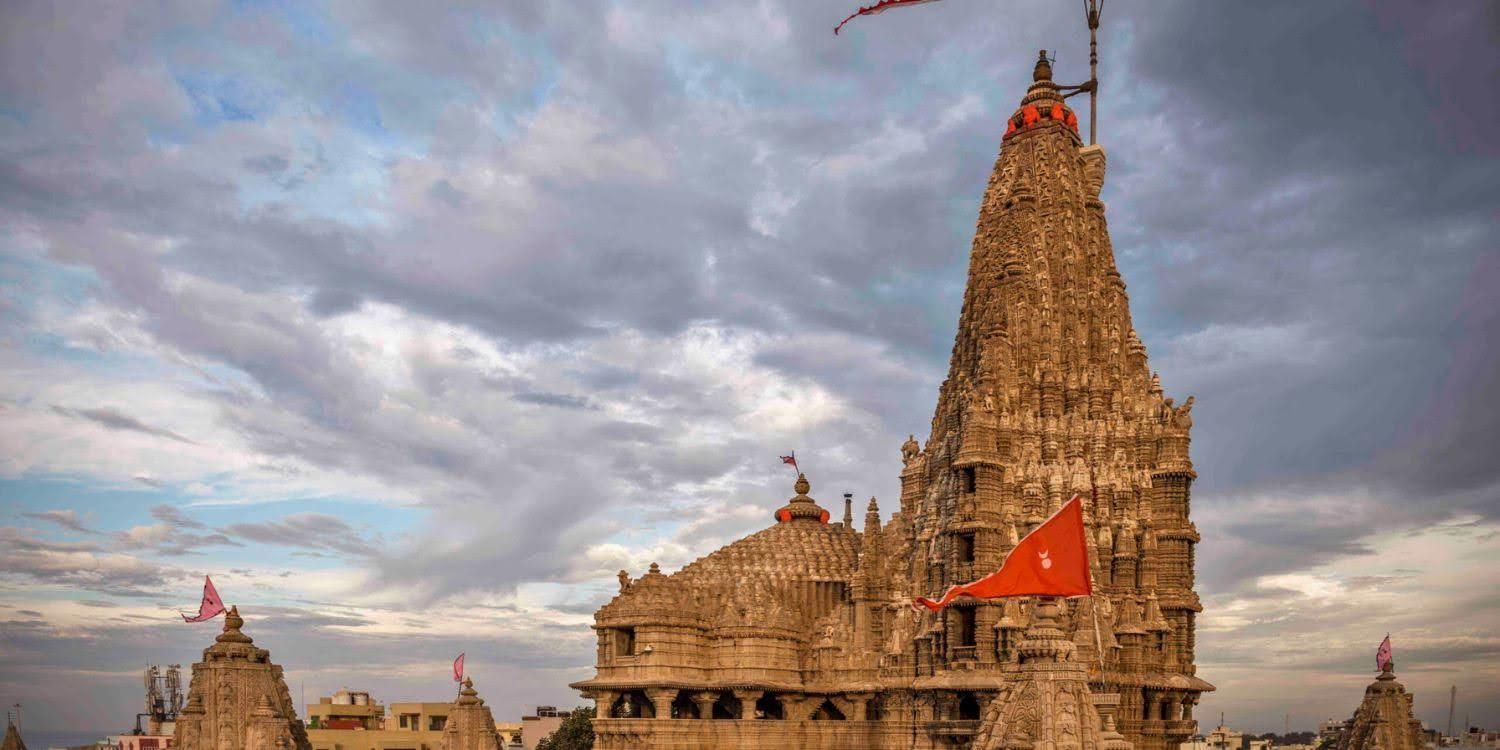The town of Dwarka in Gujarat has a rich history that dates back centuries and is mentioned in the Mahabharata epic as the Dwaraka Kingdom. Situated on the banks of the Gomti River, Dwarka is legendary as the capital of Lord Krishna. Archaeological findings, including a stone block with inscriptions and dressed stones indicating the use of dowels, along with an examination of anchors at the site, suggest that the harbour dates back to historical times, with some of the underwater structures being from the late Medieval period. Coastal erosion likely contributed to the destruction of what was once an ancient port.
In the fifteenth century, the Raja of Dwarka, a Vadhel named Bhim, ruled over the region along with the local Vagher pirates. During this time, a maulana named Mahmud Samarqandi was on a sea voyage when a storm caused his vessel to drift towards the coast of Dwarka. The ship was attacked by Vagher pirates, who plundered it, kidnapped the women on board, and left Mahmud and his sons adrift. Mahmud Samarqandi took his grievances to Sultan Mahmud at his court in Mustafabad. In response, the Sultan decided to capture Dwarka, and in 1473, he began his march towards the city. Raja Bhim and his Rajputs fled to the island fortress of Bet, allowing Mahmud Begada to plunder Dwarka, destroy buildings, and demolish the Dwarkadhish Temple, including its idol. However, according to some sources, such as a Gujarati article by Jayantilal Thaker cited by Rangarajan, the Vaghers "did their utmost to defend" the temple.
The current image of Dwarkadhish was installed by Aniruddhashrama Shankaracharya in 1559.
Who Built the Dwarkadhish Temple and When?
According to local tradition, the Dwarkadhish Temple is believed to be 5244 years old and was constructed by Vajranabh, the great-grandson of Lord Krishna. This temple is situated on the sacred ground where the original Hari Griha, or home of Krishna, once stood.
However, the current temple structure is not the original one but a composite of various constructions spanning several centuries, from the 8th to the 18th century CE. The existing temple is a result of continuous additions and renovations over time. As noted by Dwivedi Ji, the temple's structure is akin to its body, which evolves over time, while the Murti or idol represents its enduring soul. Conservation efforts by the Archaeological Survey of India (ASI) are ongoing, including renovations of related structures such as the AmbaJi temple.
Sthala Puranam :
The sthalapuranam (sacred legend) of Dwarka encompasses various stories about Lord Krishna, highlighting his journey to becoming the king, ruling the empire, and concluding his divine incarnation as Krishna.
Birth and Early Life:
- Vada Mathura: This is the sacred birthplace of Lord Krishna.
- Aayarpadi: The place where Krishna spent his childhood, nurtured by Nandagopal.
- Dwaraka: The location where Krishna's earthly incarnation came to an end.
Divine Seva: In Vada Mathura, Lord Krishna displayed his divine grace (seva) to Brahma, Indra, other Devas, and his parents, Vasudeva and Devaki. In Aayarpadi, Krishna showed his divine love to Nandagopal, who raised him.
End of Krishna's Avatar: After fulfilling his divine duties, Krishna’s avatar ended in Dwaraka. An archer named Ulupadhan mistook Krishna’s feet for a white pigeon and struck him, bringing an end to his earthly life. In Dwaraka, Krishna showed his divine grace to his wives—Rukmini, Satyabhama, Jambavati—and others, including his friends, sons, and the Yadavas. Though everyone thought Krishna belonged to them, he was indeed the protector of all souls in the universe.
Draupadi's Devotion: Draupadi, also known as "Paanjali," married the Pandavas and regarded Krishna as her brother. When she was humiliated in Duryodhana's court, Krishna protected her by providing endless clothing, demonstrating his divine grace to her as well.
King Gargeya and Kaalayavannan: King Gargeya of Mathura, who had no children, performed severe penance to Lord Shiva, wishing for a son who would rid the Yadavas. Lord Shiva granted his wish, and the king was blessed with a son named Kaalayavannan. When Kaalayavannan attacked the Yadavas, Krishna sought refuge from the Ocean King, who provided land in the ocean to build a town.
Creation of Dwaraka: Krishna asked Vishwakarma to build the town on this land, which was beautifully designed with streets and sacred ponds, resembling an entrance (Dwaram) to heaven. Hence, this place was named "Dwaraka," where all the Yadavas from Mathura were relocated.
Kaalayavannan's Defeat: When Kaalayavannan attacked Mathura, Krishna and Balarama, disguised as humans, evaded him and took refuge in a cave where Musukundan, who had a unique boon, was resting. Anyone who disturbed Musukundan would be reduced to ashes. When Kaalayavannan entered the cave and awakened Musukundan, he was immediately turned to ash. Musukundan, realising Krishna’s divine nature, sought his blessings and was promised salvation in his next life.
Kuchela’s Devotion: Another significant figure who received Krishna’s grace was Kuchela, a poor Brahmin and an old friend of Krishna. When Kuchela visited Krishna, he offered him some aval (flattened rice). Krishna, pleased with Kuchela’s friendship, offered him wealth, transforming his humble home into a grand house, symbolising the deep relationship between the Paramatma (Supreme Soul) and the Jeevatma (individual soul).
Dwarka’s Existence: Dwaraka is believed to exist in two parts. One part, near the Dwarka railway station, is known as "Gomuki Dwaraka," and the other, "Pate Dwaraka," is located 20 miles away. It is said that Krishna resided in Pate Dwaraka with the Yadavas and his consorts.
Temple Details: In Pate Dwaraka, the main deity, Dwarakanathji, is depicted standing with a conch and chakra. The temple also houses separate shrines for Kalyanarayar Krishna, Thiruvikrama Moorthy, Sri Lakshmi Narayanar, Devaki, Jambavathi, and Rukmini.
